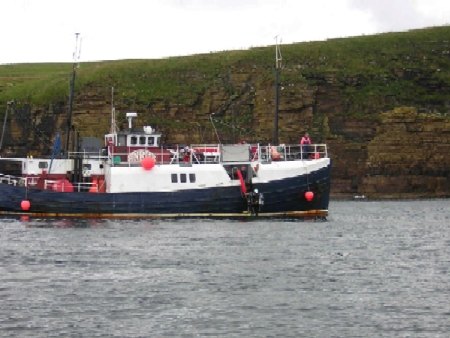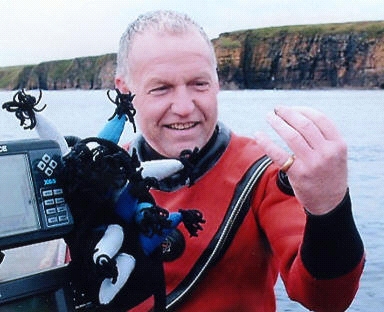![]()
The Discovery Of The Engagement Ring Of Ernest Stanley Cubiss

Once again, just like the message from Bob Sissons in 2003, I had a huge shock when I opened my email in September 2007. There was a message from somebody by the name of Bob Hamilton, that told such an astonishing tale that I had trouble taking it all in at first.
Eventually, when the enormity of the story had finally sunk in and the hairs had settled down on the back of my neck, it became obvious that once again HMS Opal had provided a truly amazing story.....
The following account and photographs are provided courtesy of Bob & Sue Hamilton, Peter Brady, Eric 'Slim' Stinson and Geoff Goodwin
As a group of like-minded divers, we have been visiting the Orkney Isles for more than fifteen years – diving from MV Sunrise, a converted fishing boat which provides live-aboard accommodation. A few years ago we decided to extend our annual trip to two weeks in order to allow additional time to visit the ‘Northern Isles’ and sample the diving opportunities outside Scapa Flow - the usual destination for dive groups and the famous location of the German fleet wrecks from World War I.
The Northern Isles trip is very weather dependant and dives are more likely to be restricted by the state of the tides. On a couple of occasions however, we had been fortunate enough to arrive in the area of Windwick Bay when conditions were favourable and dived on the wreck site of HMS Opal and HMS Narborough.

MV Sunrise in Windwick Bay
During our annual holiday in July 2007, we were again able to dive the site - on a glorious, sunny day during our journey from Stromness to Kirkwall prior to visiting the other islands. Having done some research, we were intrigued by the story of the loss of the vessels and keen to explore the area again. Both vessels were salvaged, so there is very little wreckage – just a few bits of metal amongst the rocks to show where the disaster occurred, but it is a pleasant dive in the right conditions, with a small number of seals for company.
The following day the Orkney weather did what it does best and took a very definite turn for the worse – resulting in wind and rain for the next few days and curtailing the diving to quick trips out from Kirkwall and back into harbour.
Then, during an enforced ‘day off’, a small group decided to investigate the possibility of diving in Windwick Bay from our RiB, as our skipper Dougie Leask had suggested several possible launch sites. Our intrepid explorers visited the site of the memorial to the vessels, which is situated close to the site of the disaster and located a launch site on the ‘outside’ of the Churchill barrier.
The memorial reads: In memory of the 188 men who perished here when HMS NARBOROUGH and HMS OPAL were lost on the rocks of Hesta during the snowstorm of 12 January 1918.
Following our return home, we began planning next year’s trip – as usual bemoaning the fact that we had to wait a whole year before we could go again. Whilst checking out available dates with Dougie, we discovered that he had a part-filled charter in September and after a bit of spur-of-the-moment decision making, five of our crew set off for a ‘bonus’ week.
We were joining a group of seven divers from the south east, so we knew the likelihood of visiting the Northern Isles was remote as they would be keen to see the fleet wrecks and the journey to and from the islands takes a very large junk of your holiday when you only have one week. So we decided to take our RiB with us in case we had the opportunity to revisit Windwick Bay.
After a couple of days diving in the Flow from the MV Sunrise with our new buddies, by which time the usual on board banter had overcome any north/south divide, the weather looked as though it might provide a window of opportunity to revisit the site of the Opal and Narborough. So on the Tuesday we set off to tow the boat to the launch site and attempt to locate the wreck site. With the RiB on site Geoff and Peter were first to dive, followed later by Bob, Sue and Slim. It was pleasant enough but a bit of a choppy ride in the boat and not very warm in the water, so after spending some time finning through the copious kelp we decided to call it a day. As compensation we did catch some fantastic fish – which we enjoyed for dinner on board the Sunrise.
The next day (Wednesday 12th September) the weather was again favourable and the forecast for the next couple of days not so good, so we repeated the exercise of pulling the boat out from the harbour at Stromness and towing it across to Windwick Bay. Conditions were much better, we had a smooth run out to the site, the light and visibility were excellent and we all spent about an hour in the water mooching amongst the rocks.
We had reversed the dive order from the previous day, with Peter and Geoff taking the second turn. As they surfaced at the end of the dive Peter couldn’t contain his excitement and said to us all “If what I’ve got in my glove is what I think it is, you’re not going to believe it!” They were dragged back into the boat without further ado and he took off his glove to reveal – a gold wedding ring! There was a distinct change of atmosphere in the boat as we all contemplated this find, then a further examination revealed an inscription inside the ring which read “To Stanley from Flo – 6 March 1916”. Against all odds, Peter had found the ring by digging in the sand and stones between the rocks. Fortunately Slim had his camera on board and we were able to get a photograph almost immediately after the ring came out of the water.

Peter Brady with the ring
On the journey back to Stromness we discussed what action we should take and all agreed that we wanted to try to find out more about Stanley and Flo and try to trace their descendants, and if we were unsuccessful we would return and donate the ring to the museum at Lyness, which already had some artefacts from the wrecks including a lifebelt, gun and photographs. Back on board the Sunrise, we asked Bruce (the best dive-boat ‘crew’ in the business) to print off the list of those lost in the disaster, which we knew was available on the internet (see Opal and Narborough casualty lists at gwpda.org, researched by Brian Budge).
The next morning we studied the list and found only two ‘Stanleys’ – the first of which was Ernest Stanley Cubiss, whose parents were Thornton and Maria Cubiss of Keighley, Yorkshire and whose wife was Florence Ethel Cubiss of 4 St Paul’s Square, Southsea Hampshire. ‘BINGO!!!’ We were all struck by how easy it had been to find some provenance for the ring and the ‘shivers down the spine’ from the previous day were repeated.
We shared our discovery with the rest of the dive crew and with Dougie and his wife Karen, during our celebratory dinner on the last night of the trip and they agreed with our planned course of action.
No sooner had we arrived home, unpacked the bags and loaded the washing machines, than the detective work began. A visit to the 1901 census site revealed that Ernest Stanley Cubiss was the son of a General Draper, Thornton Cubiss and his wife Maria from Keighley and was one of their five children at the time of the census. At the same time ten year old Florence Ethel Foster was listed as one of five children of Harriet Foster, who was described as the Head of the household.
Further research revealed that following Stanley’s death on 12th January 1918, Florence had remarried – to a Mr Duttson in 1929. It appeared unlikely that Stanley and Florence had a family, as their wedding didn’t take place until June 1917 – (perhaps the ring had been given to him at the time of their engagement) so we decided to attempt to trace other members of the Cubiss family.
A search revealed a telephone number for Mr M Cubiss and, with a degree of trepidation, Bob called him to see if he had any connection with Stanley’s family. At the mention of the Orkney isles, Mr Cubiss immediately interrupted with “HMS Opal” and it transpired that he was a nephew of Ernest Stanley Cubiss and was actually in possession of a number of artefacts, which had been given to him in the 1980s by Florence’s son from her marriage to Mr Duttson.
During this rather touching ‘phone call Mr Cubiss said he would be delighted for the items he had to be united with the ring and presented to the museum at Lyness. Bob and Peter then visited him at home and he confirmed his wish for the items in his possession to be donated to The Orkney Museum. The following articles were duly passed to us for this purpose:
Three medals – posthumously awarded to
Ernest Stanley Cubiss
A bronze plaque and accompanying
citation from King George V
Another scroll from King George V
commemorating those who died in the war and bearing Stanley’s name
and that of
HMS Opal (including the tube in which it was posted)
A photograph of Stanley
A small circular photo frame with a
miniature of Stanley
A ticket for a Grand Dance held by HMS
Opal in Lerwick Town Hall on July 16th in aid of St Dunstan’s Hostel
for Blind Soldiers and Sailors. The ticket, priced 1/6d admitted ‘One gentleman
and two ladies’
The marriage certificate of Ernest Stanley Cubiss to Florence Ethel Foster, dated 28th June 1917.
We have since contacted The Orkney Museum and received an email from Tom Muir, Exhibitions Officer, stating that they would be ‘honoured’ to receive the items for inclusion in the museum’s tribute to all those servicemen who lost their lives in Orkney waters.
It now remains for those involved, Peter, Geoff, Bob, Sue and Slim to deliver the items to The Orkney Museum for safe keeping. The story has so far featured on Granada Reports and in the Daily Mail. The BBC are currently showing interest and a couple of companies are keen to film the ‘handover’ of the items to the Museum. This will probably take place when we go up for our holiday next year in August – or possibly in April if we manage to squeeze in another ‘extra’ week, unless of course we can interest anybody sufficiently to fund a trip sooner!!
Postscript 03/09/08:
The engagement ring and several other artefacts have now been presented to the Orkney Museum by Bob, Peter and friends. A report by the BBC can be found here
Please click on the thumbnails to open a larger image in a new window....
The following images taken at
Utley Cemetery, Keighley, West Yorkshire
were kindly provided by Wendy Sutherland.
Please follow these external links to read and hear the story
as published by the BBC